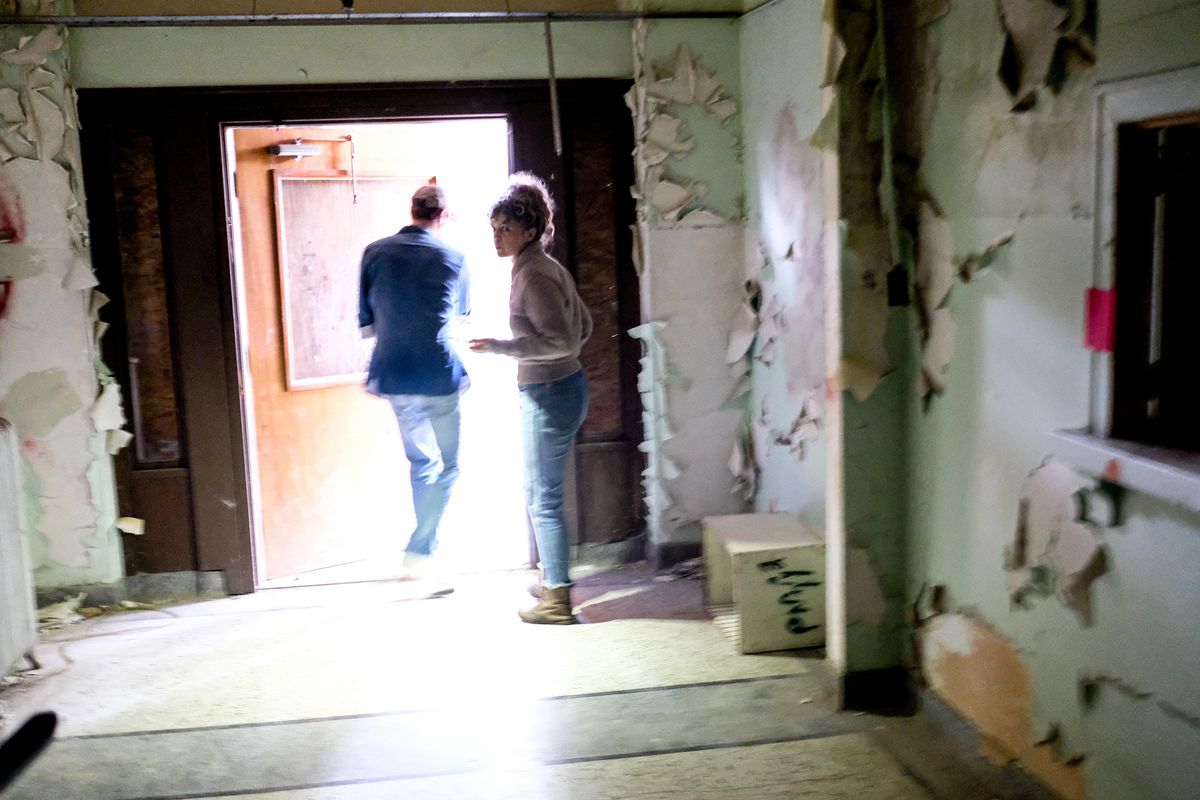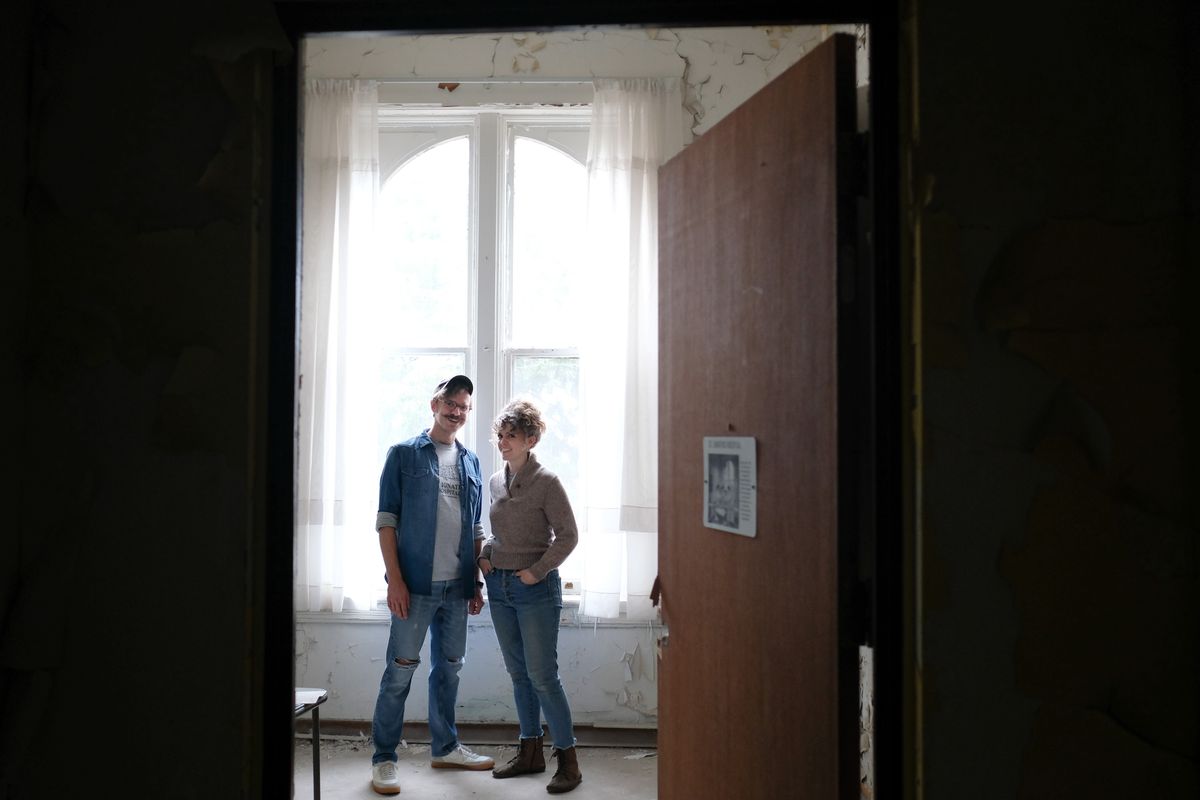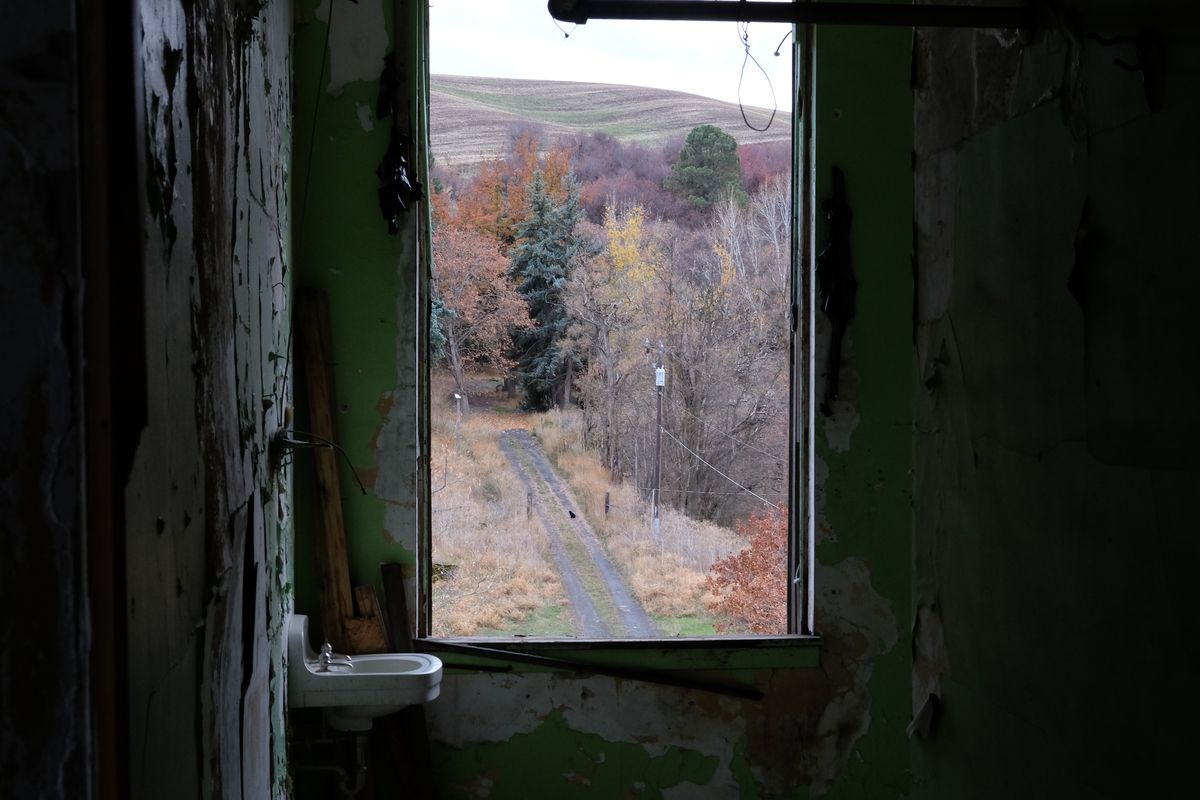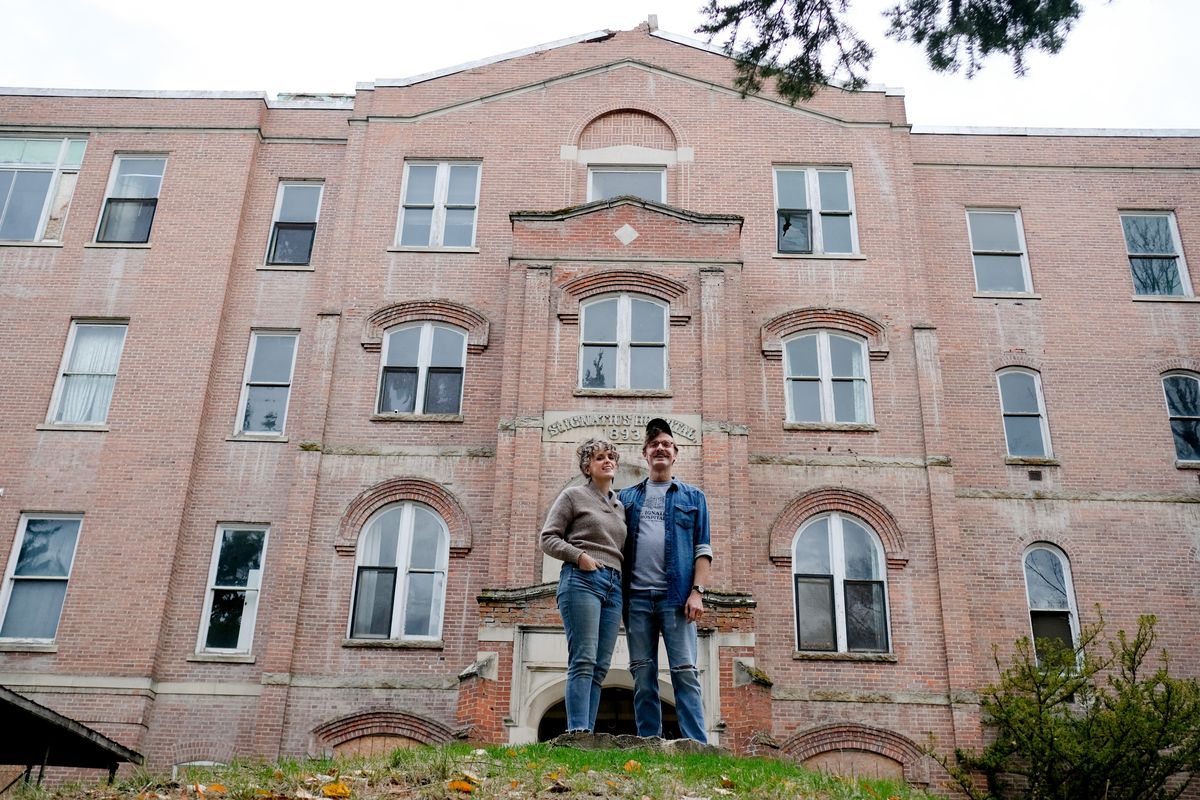St. Ignatius Hospital’s new owners aim for a balance between community and creepy with the long-abandoned building in Colfax. Can it be done?
Austin and Laura Storm open the front doors to the closed St. Ignatius Hospital on Thursday in Colfax, Wash. The Storms recently bought the abandoned building. (Tyler Tjomsland/The Spokesman-Review)Buy a print of this photo
COLFAX – On a modest square plaque outside St. Ignatius Hospital in Colfax, a Latin inscription recalls the derelict 1893 building’s mission: CHARITAS CHRISTI URGET NOS, or, roughly, “The love of Christ impels us.”
It’s also a phrase used in exorcisms.
Austin Storm, who bought the long-abandoned brick structure on the Palouse this spring with his wife, Laura, is quick to point out the dual significance, considering the former Catholic hospital has evolved into a hot spot for paranormal tourism.
“I don’t think they intended that resonance,” Storm said while standing near the stone plaque.
The competing symbolism also aligns with the Storms’ vision for St. Ignatius: renovate the sagging building into a mixed-use commercial facility, but keep some of the creepy factor that’s drawn social media influencers and paranormal TV shows to the campus at the dead end of South Mill Street.
“They said, ‘You’re going to keep the historic tours and the paranormal, right?’ ” Whitman County Historical Society Director Valoree Gregory, who leads those tours, said of the organization. “(Austin) and Laura, they said, ‘Yes, we’re not going to screw up a good thing.’ ”
But the building needs major repairs, with a gaping roof, peeling lead paint and puddles on the floor. The Storms partnered with the Whitman County Historical Society on an IndieGoGo campaign to raise renovation money, with a $50,000 anonymous donation to inspire would-be donors.
Austin and Laura Storm open the front doors to the closed St. Ignatius Hospital on Thursday in Colfax, Wash. The Storms recently bought the abandoned building. (Tyler Tjomsland/The Spokesman-Review)Buy a print of this photo
“Everyone who’s a fan of the building has seen it get worse, so everyone has a really strong understanding that, unless we start working on making it better, preserving it, that eventually it won’t be there anymore,” Storm said.
While some are skeptical of the ability – or suitability – for improvements, the Storms and their supporters see the hospital as a sort of macabre economic lightning rod for Colfax that also honors its past.
“There’s room for both,” Storm said. “That’s our hope, is we see the beautiful architecture and … all the incredible things it could do for this community and the broader Palouse.”
‘A communal loss’
Built for $40,000 in the last decade of the 19th century, St. Ignatius was the largest building in Eastern Washington at the time.
A pioneer who moved to Washington in 1862. A once-wealthy money lender who died a “pauper” and a ward of the county. A young boy who was overcome by a sudden illness after a camping trip . These are some of the patients whose lives ended inside the walls of St. Ignatius, according to newspaper archives.
Designed by Mother Joseph Pariseau, a renowned architect and missionary whose birthday is a state holiday in Washington, St. Ignatius ceased operations as a hospital in the 1960s and eventually turned into a long-term care facility, shuttering shortly after the turn of the millennium. It was owned at one point by Derrick Fincher, who was convicted of fraud in 2018.
“You get a strong sense that this is not how this is supposed to be,” Storm said of the building’s derelict status. “Something has really gone wrong. Like, this is a communal loss.”
Storm unlocked the former hospital’s south door and stepped inside on a blustery fall morning to survey the damage after a night of heavy rain.
“This is the trouble spot,” he said as he stepped over an interior puddle, guided by his phone’s flashlight.
The Storms, who own a vintage clothing store in town, were first drawn to the hospital about seven years ago through their mutual love of old things.
“We had the day off and we were rafting down the Palouse River, and (Laura) was like, we should go to Colfax and see if we could find this place,” Storm recalled. “We really were just blown away by it.”
It’s not the couple’s only connection to a historic hospital. They were both born in the same building in Maryland that’s since been torn down, but didn’t meet until they lived in the Northwest. The long saga of trying to make St. Ignatius part of their story kicked off that spring day.
“I think at the time we were like … we’ll move into it and we’ll invite our friends to move into it as we’re fixing it. It was very bohemian,” Storm said of the couple’s initial plan for the building. “It’s still bohemian, but maybe less crazy.”
Up on the third floor, Storm peered out the paned window of an enclosed balcony built for tuberculosis patients (doctors prescribed them plenty of sunlight and fresh air). There are several of these sun-drenched hideaways in the building, overlooking a “very Gothic” swath of spindly trees, and Storm sees their modern potential for something very different.
“They would make the most beautiful little artist’s studios,” he said, or maybe a greenery-filled sitting area for a hotel.
Below, an abandoned outbuilding is scrawled inside with black graffiti that reads, “BLEED.”
While tours stopped in 2018, the Storms started them up again shortly after they bought the campus, though some areas are blocked off for safety.
Gregory has been leading tours there since they started about seven years ago. The city was on board with the idea, she recalled, but with reservations – one official cautioning that the building was “abandoned and gross.”
“I go, ‘I know, it’s wonderful,’ ” Gregory said with a laugh.
She made a website advertising the tours and posted about them on Facebook. Within eight hours, Gregory said, all the tickets sold out.
“It really has made a huge difference in our community,” said Gregory, who also owns Colfax Mercantile downtown. “It really brought kind of a little spark back to Colfax.”
Businesses even started using the spooky hospital as a marketing tool. They put stickers with its likeness in their windows that read, “Ghost towns happen when you don’t shop local.”
Storm admits he’s never caught a whiff of the paranormal in his considerable time renovating the building, but it’s “something I’m totally willing to believe in.”
“I don’t say that to dismiss other people’s experiences,” said Storm, who had his Anglican priest bless the building. “I love that that is a point of contact that people have for the building. And I think for many people, it serves for an evidence that there’s more to the world than what we can see.”
Maybe it’s just practical.
“I do think it’s possible that you get what you put into it, and that, because I have to put a lot of time working into the building, I typically try not to open myself up to getting creeped out,” he said.
But for others, that’s the point.
‘Just part of Colfax’
One of the first signs greeting visitors who make the meandering country drive into Colfax reminds them: “We’re still here.”
A little farther into town is the neighborhood surrounding St. Ignatius. Well-prepared for Halloween on a recent morning, a modest white home there had an inflatable purple haunted castle out front marked by an “Enter if you dare” sign.
A block or two away, St. Ignatius is guarded by similar signs year-round.
“NO TRESPASSING.”
“DO NOT OCCUPY.”
For Pasha Rudenko, who lives and works nearby, those messages carry serious weight. But he sees plenty of people disregard them.
“Right now, it’s an environmental concern for everyone, and people who live right here the closest should be the most concerned,” he said.
Rudenko said he clears shrubbery from the embankment leading up to St. Ignatius’ main building because he’s seen kids sliding down it for fun. Then there’s the people who actually want to go inside.
“I hope something good happens with it, and I would be really upset if it remains a dump,” Rudenko said of the building.
Still, he’s skeptical.
“As a dump,” Rudenko said, “it makes more money than anything else.”
But Rachelle Marshall welcomes spooky tourism in the neighborhood – “people like to be scared,” she pointed out.
Marshall lives in a home she said is haunted, and her family owns a house next door that she said used to be occupied by St. Ignatius’ single nurses. She and her husband had hoped to buy St. Ignatius themselves, but now they want to turn the white-and-blue nurse house into a spooky Airbnb for visitors to the hospital, complete with Victorian furnishings.
“We’re trying to get it back to being a nice neighborhood,” Marshall said on a break from raking leaves.
While she’s never seen ghosts in her house, Marshall noted that she’s told them to stay away.
“A lot of original wallpaper in there, when I touch it, you can feel the sadness. I know that sounds weird,” said Marshall, who claims her husband and son have seen ghosts there. “And then you can touch other wallpaper and it’s not sad. So it is almost like it overwhelms you.”
Rudenko, who works into the night from his home office, isn’t convinced.
“I’m the only ghost around here,” he said.
Plenty of people are willing to buy into the creepy, though – with tickets. One of Gregory’s recent tour groups was from Boston, while the next day’s was from Texas, and she said both came just to see the hospital.
Long before she led tours there, the Colfax native said St. Ignatius already served as the town’s de facto haunted house.
“We used to go up there and it was, like, terrifying,” she said. “I think it’s just part of Colfax.”
Gregory has also seen the hospital’s heart. After all, she was born there and grew up when it was in use.
“The people who lived there were really part of our community. They came to basketball and volleyball games. It was just there,” Gregory said. “It was just always part of our lives.”
While Gregory wants Colfax to tap into its full potential, she acknowledged that some residents worry it would change the character of the town.
“The neighbors are all like, ‘Oh, we don’t want, like, fancy apartments or anything, because this is our neighborhood,’ ” she said.
Still, she believes there’s room for improvements without sacrificing the spirit of Colfax.
“If a haunted hospital can bring a town back,” she said, “people can do anything, right?”


















